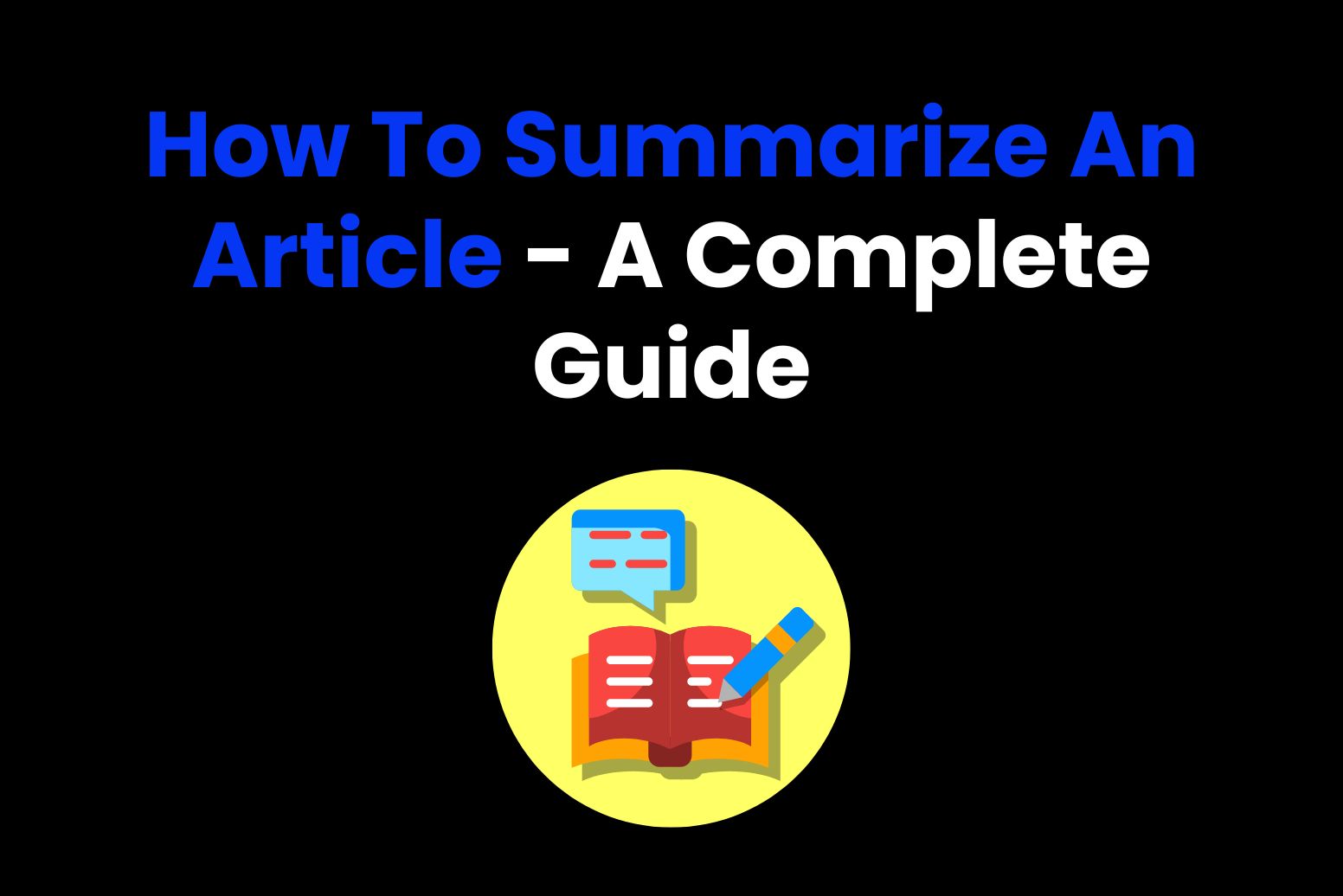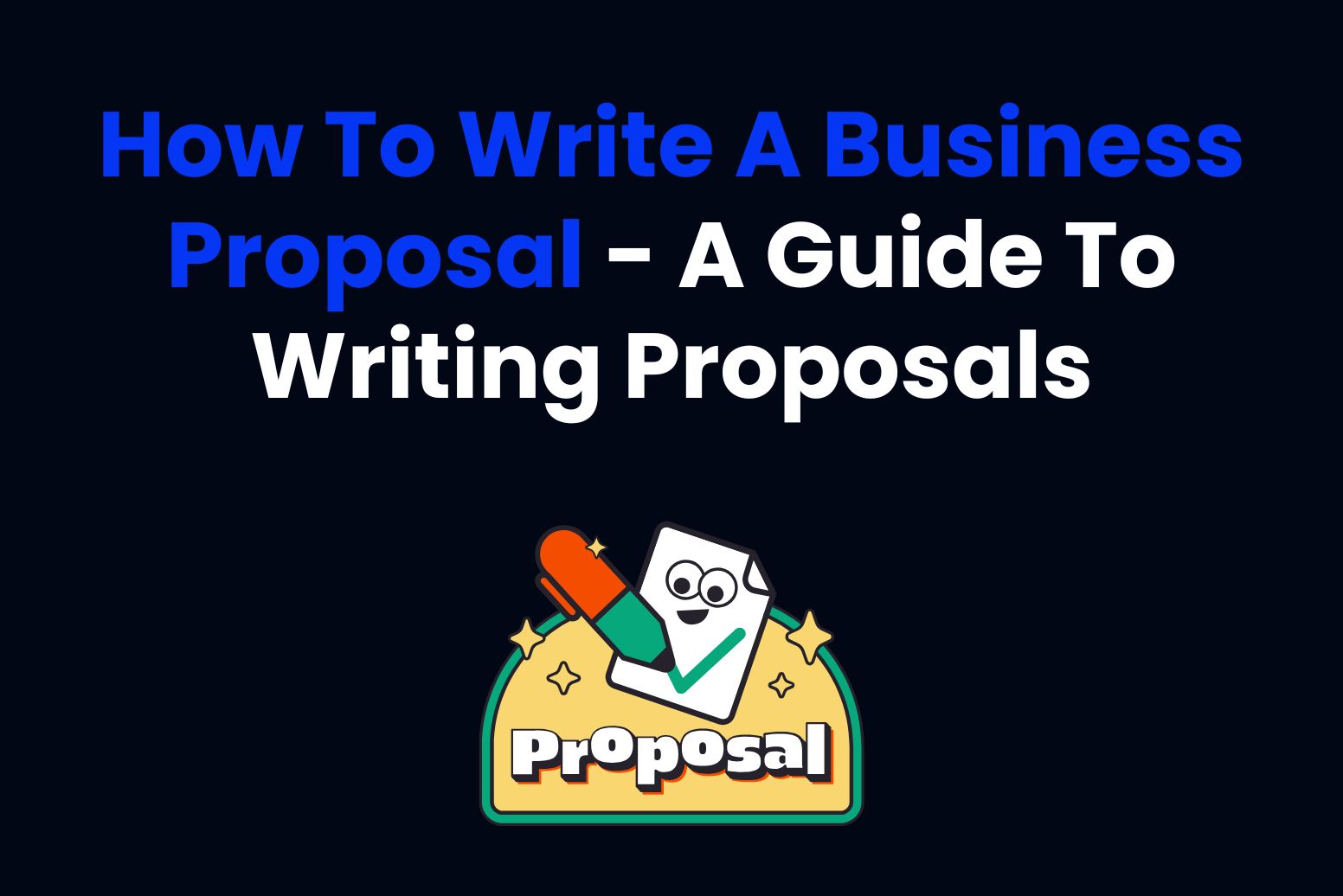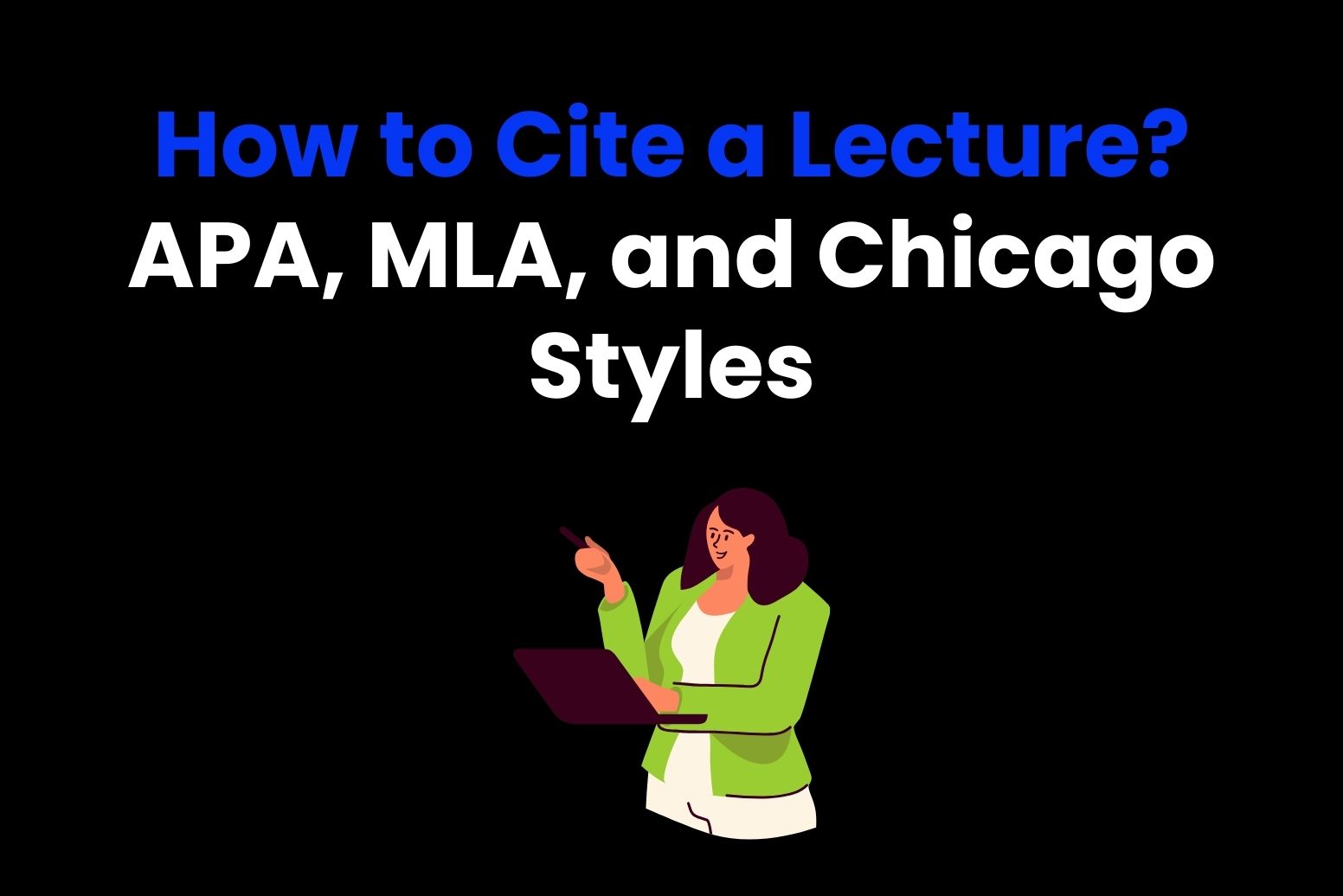Do you sometimes find yourself in a position where you don’t have time to read an entire article? At that point, do you wish someone had summarized it for you to skim through? Whether you’re a student cramming for exams or just someone trying to save time, knowing how to summarize an article is a superpower you need in your toolkit.
The good news? It doesn’t have to be boring. In this guide, I’ll walk you through how to summarize an article like a professional so that you can be the smart one at your annual dinner parties. So grab your favorite beverage, and let’s get into it.

What Is A Summary Of An Article?
An article summary is exactly what it sounds like: a concise and focused version of a larger article. It is a way to get the main idea and key points without wading through pages of details. You’re not rewriting the whole thing, just capturing the essence.
This includes what the article is about, the big takeaways, and why it matters. Basically, it captures the main ideas, key points, and overall message of the original text in a much shorter format without adding personal opinions or extra details.
Why You Should Know How To Summarize An Article?
Before we get to the how, let’s talk about the why. Summarizing an article isn’t just some academic exercise; it’s a practical skill with real-world benefits. Here’s why you should know how to summarize an article:
- Save Time: A summary gives you the gist of an article in minutes instead of hours, and yes, without reading 5000 words.
- Makes You Sound Smart: Perfect for explaining something without needing to Google it mid-conversation.
- Keeps Things Clear: Whether you’re summarizing for work, school, or your best friend, it helps you focus on what’s actually important.
Imagine you just read a long article about climate change. Instead of boring your friends with every tiny detail, you say: “Basically, it’s about how renewable energy is key to slowing down global warming. They backed it up with stats on solar power adoption and some cool examples of cities going green.” And that, my friends, is an example of an article summary!
Step-By-Step Guide On How To Summarize An Article
Here’s how you can summarize an article following these easy steps:

Step 1: Read The Article Like You Mean It
The first step in mastering how to summarize an article is actually reading it. But not just any reading; we’re talking about intentional, focused reading. Here’s how you should read an article that you’re about to summarize:
Skim The Article First
Before diving deep into the article, you should scan the article for structure:
- Look at the title, subheadings, and intro/conclusion. These often hold the key points.
- Check for bolded text, bullet points, or graphs since they usually highlight important information.
This step is like watching a movie trailer: it gives you an overview without the commitment.
Read Thoroughly
Now it’s time to roll up your sleeves and dive deep into the article:
- Read the article from start to finish without skipping around.
- Highlight or underline key points as you go.
Pro tip: If you’re tempted to skim (again), remind yourself that a solid first read saves time later.
Pinpoint The Big Idea
Every article has a main point or argument, also known as the thesis statement. Ask yourself:
- What’s the author trying to say?
- What’s the one thing they want me to remember?
If you’re able to find the big idea, congratulations you’ve cracked the code to a puzzle which is going to make everything else fall into place.
Step 2: Identify The Main Points
To truly master how to summarize an article, you need to separate the wheat from the chaff. Here’s how you can zero in on the good stuff:
Locate The Thesis Statement
The thesis statement is the backbone of any article. It’s often found in the introduction or conclusion and sums up the article’s main idea. You can also use a thesis statement generator to help you out.
For example: “The rise of electric vehicles is transforming urban transportation.”
Highlight Supporting Points
Once you’ve nailed the thesis, look for the points that back it up. These include:
- Key arguments
- Data or evidence
- Real-life examples
Cut The Fluff
Not everything in the article is essential, so don’t just add anything and everything. Skip the anecdotes, side stories, and flowery language, and definitely don’t repeat the same thing again and again with just different wording. Focus on the core message and supporting arguments to make your article summary valuable and helpful.
Step 3: Paraphrase The Content
If you’re serious about learning how to summarize an article, you need to master the art of paraphrasing. Why? Because simply copying text is boring (and plagiarism, too). Here’s how you can paraphrase your content effectively:
Simplify Complex Sentences
Have a look at this sentence and see how tough it is to read. Take this sentence:
“The ongoing advancements in renewable energy have catalyzed a shift in global economic paradigms.”
Turn it into this:
“Renewable energy advancements are changing the global economy.”
Same meaning, fewer headaches, right?
Keep It Concise
Paraphrasing isn’t just about using different words but also about using fewer words. Try to avoid unnecessary details as much as you can while retaining the core message.
Maintain Neutrality
Remember, a summary isn’t the place for your opinions; it’s about what the author has said in the article. Stick to what the author is saying in the article, and save your hot takes for Twitter.
Step 4: Organize Your Summary
Knowing how to summarize an article is half the battle, while organizing it into a readable and enjoyable summary is the other half. If your summary is well-structured, it ensures your ideas flow logically and are easy for people to follow.

Follow The Article’s Structure
Always remember that you need to keep your summary in the same order as the original article. Generally, this is the way an article is structured, and so should be your summary:
- Introduction: State the article’s thesis.
- Body: Outline the main arguments or points of the article.
- Conclusion: Highlight the author’s final thoughts or their recommendations.
Your summary is like a map, so guide your reader from start to finish without taking any detours.
Choose Your Format
The way you format your summary is like picking the right outfit; you’ve got to match it to the occasion. Here’s how it works:
Bullet Points:
If you’re trying to get straight to the point and don’t want to overwhelm someone, bullet points are your best friend. They’re perfect for quick and punchy summaries. Here’s when to use them:
- You’re in a meeting and need to drop the key points fast.
- You’re texting someone about what an article said (but don’t want to write an essay).
- The article is so jam-packed with info that organizing it into bullet points will save everyone’s brain from exploding.
Paragraphs:
Sometimes, you’ve got to go the extra mile, and paragraphs can help you in this situation. They’re for when you need to sound a little more polished. Here’s when to use them:
- Writing a report for work or school.
- Explaining something in a way that flows, like if you’re recapping a story or an argument.
- Making it feel like you actually put in some effort (because, let’s be honest, paragraphs take a little more time).
Step 5: Revise And Polish
The final step in how to summarize an article is revising your work. Even the best summaries need a little fine-tuning, so why not?
Check For Accuracy
Okay, guys, it’s time to play detective! Go back to the article and compare it with your summary. Ask yourself:
- Have I captured all the major points?
- Did I accidentally leave out something important?
- Did I get anything wrong or twist the author’s meaning (oops!)?
Basically, your summary should feel like a mini version of the article, not a remix or your own take on it. If it doesn’t reflect what the original article was saying, it’s time for a quick fix. You can also get help from a senior or colleague to see if their interpretation is similar to yours.

Trim The Fat ((Keep It Lean And Clean)
Let’s be real, sometimes we get carried away and write too much. But summaries are like snacks, not full meals. They’re supposed to be quick and light, not stuffed with extras.
- Cut out repetition: Did you say the same thing twice but in different words? Cut it out!
- Ditch the fluff: If it doesn’t add value, it’s time to take it out.
- Keep it tight: Focus on the essentials. If your summary feels like it’s dragging, you’ve probably gone overboard.
For example, instead of:
“The author talks about how meditation can be helpful in reducing stress and explains that stress levels can go down because meditation lowers cortisol, which is a hormone connected to stress.”
Go with:
“Meditation reduces stress by lowering cortisol levels.”
Short, sweet, and gets the job done!
Proofread Like A Pro
Imagine you write an amazing summary but leave a typo like “summery” instead of “summary.” Here’s how you can avoid it:
- Read it out loud: You’d be surprised how many mistakes you catch just by hearing it.
- Take a break and come back: Giving your brain a rest before proofreading helps you see mistakes more clearly.
- Use a grammar-check tool: You can use ChatGPT prompts for proofreading or tools like Arvin AI’s Grammar checker; they are lifesavers for catching sneaky errors. Try it out here: https://arvin.chat/en/home?menu=grammar.
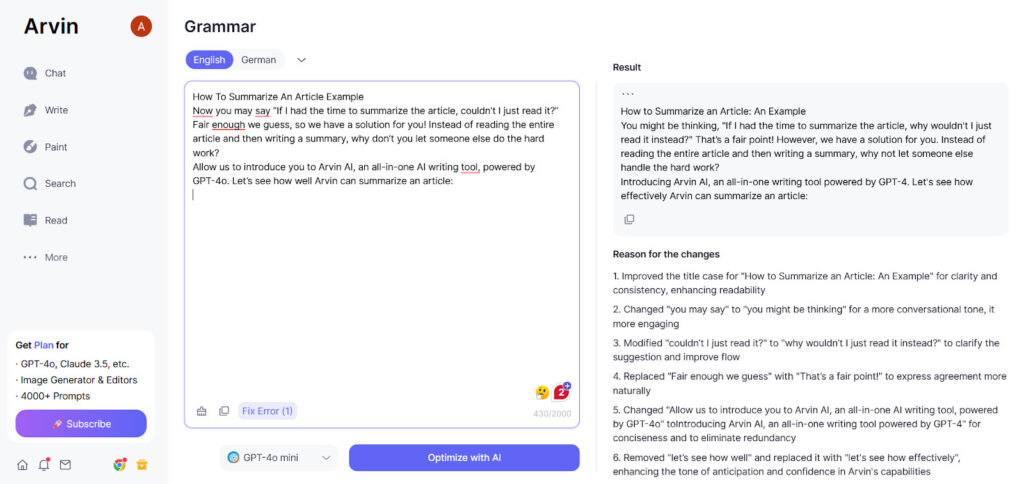
The best part about this grammar checker is that it gives you reasons for making the changes it recommends, so you can learn from your mistakes as well. Cool, right?
How To Summarize An Article Using AI
Now, you may say, “If I had the time to summarize the article, couldn’t I just read it?” Fair enough, we guess, so we have a solution for you! Instead of reading the entire article and then writing a summary, why don’t you let someone else do the hard work?
Allow us to introduce you to Arvin AI, an all-in-one AI writing tool powered by GPT-4o. Let’s see how well Arvin can summarize an article:
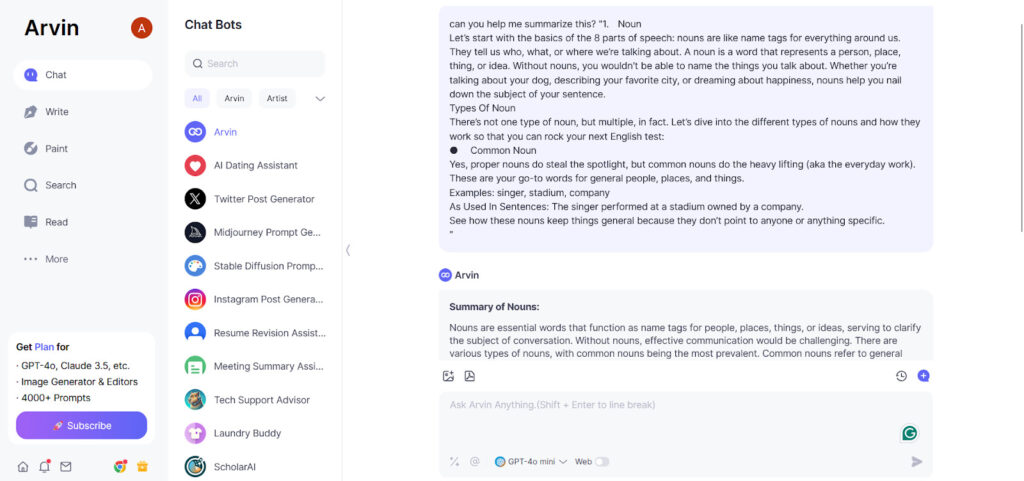
See how Arvin summarized those large paragraphs into a few lines? Don’t forget to get Arvin’s help whenever you can, and save time and energy!
Common Questions About How To Summarize An Article
Here are a few of the most frequently asked questions about how to summarize an article:
How long should my summary be?
A good rule of thumb is to aim for 10-20% of the original article’s length. For example, if the article is 1,000 words, your summary should be around 100–200 words. However, this length can vary depending on the context.
What if I disagree with the article?
It’s totally fine to disagree with the article. However, a summary isn’t the place to argue. Your job is to reflect the author’s message as accurately and neutrally as possible, even if you don’t agree with it. Once you’ve summarized, you can always include a critique or your thoughts in a separate section.
How do I practice summarizing effectively?
For extra practice, you can:
- Summarize an article for a friend and see if they understand the gist.
- Challenge yourself to summarize in 100 words, then 50, then 10.
- Read book blurbs or movie synopses for inspiration—they’re pros at condensing content!
How do I summarize an article with lots of opinions?
When summarizing an opinion-heavy article, focus on the main opinion or argument of the author. You can also mention the reasons and evidence they use to back up their opinion, as well as any contrasting viewpoints mentioned.
Final Thoughts
Learning how to summarize an article isn’t rocket science, and you can master it with a little bit of practice. Remember to read carefully, focus on the main points, paraphrase effectively, and organize your thoughts. The best part? The more you practice, the easier it gets. And even better, if you feel tired at any point, you always have Arvin AI to your rescue!

